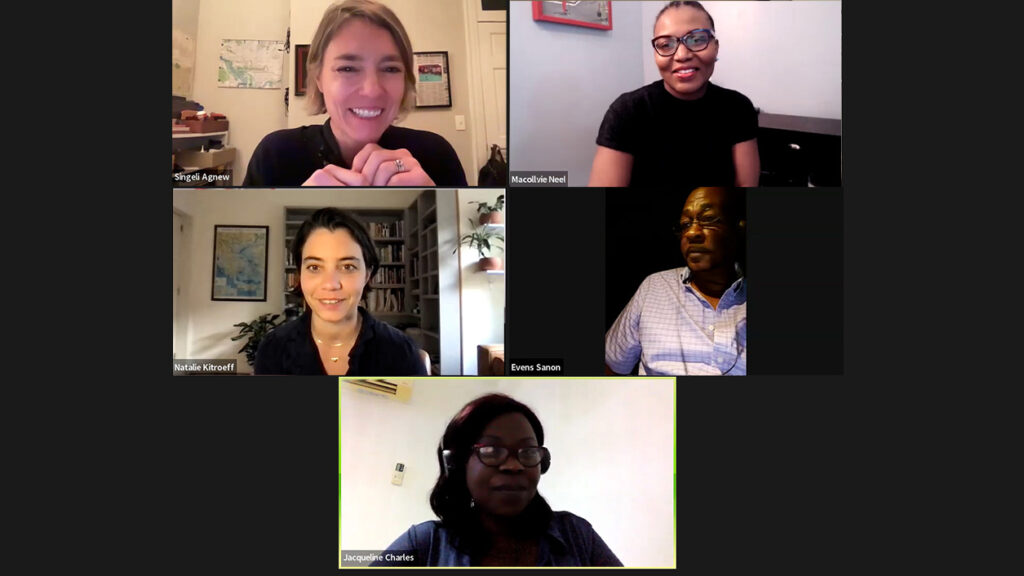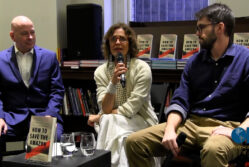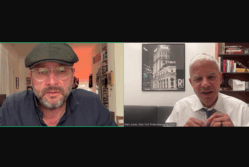Event Coverage Highlight

OPC Launches ‘In the Thick of It’ Series With Discussion on Challenges in Haiti

Clockwise from upper left: Singeli Agnew, Macollvie Neel, Andre Paultre, Jacqueline Charles and Natalie Kitroeff.
On Jan. 26, while Haiti was still reeling from the killing of six police officers the day before, the OPC hosted an online panel discussion with reporters who have been covering turmoil in Haiti over the past year.
The inaugural program of a new OPC discussion series earned its title, “In the Thick of It,” as angry protestors had just attempted to breach the international airport, searching for Prime Minister Ariel Henry and demanding a response to the series of attacks on police; several of the panelists had been covering the protests and some were still on deadline.
Moderating the discussion was Singeli Agnew, a governor of the OPC and an independent cinematographer, producer and director of documentary films, who cited a recent report from the Committee to Protect Journalists (CPJ) that placed Haiti third on a list of the deadliest countries for journalists in 2022, behind Ukraine and Mexico, with a total of seven killed there.
Andre Paultre, a freelance Haitian reporter who has worked for The New York Times and other major outlets in Haiti for more than a decade, said journalists were still untangling events of the past 24 hours, adding that some roads had been blocked with burning tires since the night before and people wearing police uniforms were stopping cars and taking keys from drivers.
“Haiti’s always unpredictable, and now we’re just in the middle of chaos. Things might go back to normal. It would not be the first time. But it could become worse,” he said.
Unrest in Haiti has been escalating for years. The assassination of president Jovenel Moïse in July 2021 left a political vacuum and environment of uncertainty amid a worsening socio economic crisis and the rise of powerful gangs. Kidnappings and violence have increased in the years since, severely impacting the work of reporters.
Jacqueline Charles, a veteran Haiti and Caribbean correspondent for the Miami Herald, had been on the tarmac of the airport only hours earlier.
Charles noted the long list of hurdles reporters face on a day-to-day basis: “Everybody is afraid to talk…moving around is not easy.” But she said that simply above all else, “the biggest challenge right now is democracy is under fire.” She added, “It’s no longer about ideology – it’s basically a competition for power.”
Paultre explained that safely navigating the city, especially with non-Haitian colleagues who attract additional attention, now requires having trusted contacts in every neighborhood and constant communication with a wide network of sources.
“More than 70 percent of the capital is under gang control,” Paultre said. “Everywhere is a no-go [zone] now,” even upscale neighborhoods that have always been safe, he said. “You can’t get your story in three days like other places,” Paultre added. “Getting people to talk, moving, verifying info – all of it is difficult. You have to be patient.”
Natalie Kitroeff, New York Times bureau chief for Mexico, Central America and the Caribbean, said it’s a constant exercise in flexibility. “We’re evaluating moment to moment and street to street.”
Kitroeff noted that in this environment, she’s especially cognizant of the need for international journalists to keep the safety of their Haitian colleagues and sources at the forefront. “As a journalist, there’s always the drive to want to be in the middle of the action, she said, but “everything that we do, can affect [their] work, and when we leave, [they] stay.”
Macollvie Neel, executive editor of The Haitian Times, a news source serving the Haitian diaspora since 1999, said the organization started shifting how it operates in Haiti in 2021 amid a rise of kidnappings and killings that made it harder for its correspondents to be safe.
“We’ve told them also very explicitly to think of Haiti as a conflict zone,” she said. “It’s a war zone. People are dying left and right, there’s no police force, there’s no justice system that works.”
“When you have a political vacuum – when democracy is at stake – that permeates everything else,” Neel added.
The media is especially vulnerable to manipulation by the politicians and the business elite, Neel noted. That has called for even greater discernment when vetting the credibility of sources, their agendas and affiliations.
One of the biggest reporting challenges in Haiti is the need to check facts extra carefully and use multiple sources to verify information, especially when dealing with a government that isn’t forthcoming, echoed Charles. “This is a place where rumors become facts, so you really have to have your reporting chops.”
With so many reporters having to leave the country, or being unable to travel to Haiti from the states, Neel said The Haitian Times realized they had to try to build what was missing itself. The organization devoted resources and sustained focus to training a professional corps of reporters that can potentially become the next generation of media leaders in Haiti.
But she said that for this to be sustainable, The Haitian Times focuses on getting stories that do not put their reporters at the highest levels of risk.
“When we kicked off our bootcamp to recruit journalists last year, some of the very first questions they asked were, ‘what kind of equipment are we going to get – are we going to have Kevlar vests?’ And our answer was ‘no, you’re not, because that’s not the type of reporting The Haitian times wants you to do. We don’t want you to go out and put yourself in the line of danger just to report that there’s another volatile situation and people are being killed. We don’t want you to be a CPJ statistic.’”
Neel said they’ve had to be more creative about how they get information, using more citizen journalism in violence-torn neighborhoods, in addition to making sure they include the context and nuance that The Haitian Times readers seek.
Evens Sanon, a Port-au-Prince-based reporter for The Associated Press, said Haitians are often scared to talk to journalists, or want to speak anonymously. He said earlier on the day of the panel that two of his journalist colleagues were told at gunpoint by people in police uniforms to stop filming and taking photos at protests.
Access that most journalists – even local journalists – used to have, just doesn’t exist anymore. “If you don’t have ‘contact’ with the community leader, the gang leader in a certain area, if you go in, you have a chance to leave an area without your notebook, your recorder, whatever you have. Threats are always there,” Sanon said. And when you add the extra visibility of working with foreign press, or with people with cameras, it’s another ball game entirely, he said.
Despite the difficulties, Kitroeff emphasized the commitment she feels to the coverage: “It’s not easy, and it’s slow, and you don’t know what you’re going to get, and the scenario on the ground is so volatile but [we’re] convinced that what is happening in Haiti is one of the most important and consequential moments in the region,” and she’s encouraged by the support she’s had from The New York Times to keep the spotlight on.
All the panelists noted the importance of collaboration and sharing of updated information in the current security environment. “I think the thing that brings people together is this intense desire to have the truth get out, and the obstacles you face in doing so,” Kitroeff said.
Sanon emphasized the need for political will for the security situation to improve, and the important role journalism can play in that regard. “If we ever have political will among the politicians that are hungry for power…security can be reestablished.” He added, “It’s the politicians that are fighting among [themselves] through the gangs, for power.”
“The thing that I’d like to leave the audience with,” Neel concluded, “is [that] we’re all trying to humanize Haiti – I see that in the coverage.” She said even just five years ago, it was common to see so many tropes and stereotypes in the way Haiti was discussed in the press, and that journalists are now increasingly aware of their role in pushing beyond the ‘easy’ descriptions.
“The more we keep talking about Haiti…the more that we can bring out those voices on the ground…the more we’ll change the narrative arc for Haiti [and] help the country move in the right direction,” she said.



